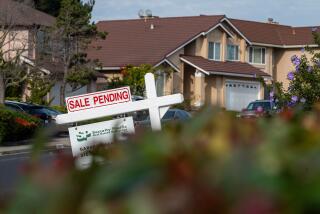Home prices may be stabilizing, market tracker says
Another sign emerged that the nation’s struggling housing market may be nearing its bottom as a widely followed national home-price index posted its first gain in nearly three years.
The S&P;/Case-Shiller index of home prices in 20 metropolitan areas was up slightly in May over its April level for the first time since 2006.
Cleveland, Dallas and San Francisco showed the largest gains in May figures released Tuesday, but Los Angeles prices continued to fall. The index was the latest surprise following reports showing monthly gains in new-home sales and housing starts nationwide, and higher median home sales prices in California.
“The data do show for the first time in quite a few years some potential signs of turnaround,” said Maureen Maitland, vice president of index services at Standard & Poor’s.
But “in terms of a sustained recovery, we’re not out of the woods yet,” Maitland cautioned. “What we need is for this to continue for quite a few months.”
The nationwide index of house prices was still down 17% in May from the same month last year. But the rapid deterioration in prices has slowed since January.
Many housing market analysts agree that cheers over a few bright spots in the data must be weighed against a more complex range of indicators. Home prices are still falling in many areas, with high unemployment and looming foreclosures likely to weigh down real estate for the foreseeable future.
Even the May index rise over April -- by a half-percentage point -- turns out to be a decline when adjusted for seasonality.
May is a busy month for home sales, which usually bumps prices up. Seasonally adjusted, the index for May was down by nine-tenths of a percentage point from April.
The slowing decline in home prices means “the free fall housing has been in is clearly over,” said Dean Baker, co-director of the Center for Economic and Policy Research in Washington. “But I’m not confident at all we’re seeing the end of the period of price declines.”
Mortgage interest rates and unemployment are rising, and “we continue to have a massive oversupply of houses by every measure,” he said.
Such mixed signals are prompting confusion for homeowners and potential home buyers, and it brought warnings from veteran housing market observers.
“We are extremely concerned that policymakers, banking and real estate industry executives, investors and others will use misleading home price data to conclude that home prices have stabilized. They have not,” John Burns, a widely followed Irvine consultant to home builders, wrote in a recent note to clients.
The glut of unsold homes was the mostly overlooked part of a report Monday that new-home sales jumped 11% in June over May. New-home sales were so low in May, however, that even with the double-digit percentage increase, June’s new-home sales total was still the lowest for the month since 1982.
The median home sales price is another point of confusion. It has been rising in California and Southern California recently. The California median was up 7% in June from May, to $246,000, according to San Diego-based MDA DataQuick.
But the rise in median price actually reflected falling prices of homes in more expensive neighborhoods, not an end to the downturn. That prompted more sales of relatively pricey properties, changing the mix of all homes sold to a higher-value grouping.
Because the median is the middle of all values, it rises when the group is made up of higher-valued members. So the median can rise even as prices fall -- as long as the prices are falling at the higher end of the market.
Until January, the Case-Shiller index had been declining at a record pace for 16 straight months. Since then, the slide has slowly become less severe.
The index compares the latest sales of detached houses with previous sales and accounts for factors such as remodeling that might affect a house’s sale price over time. From those data, an index score is used to show price changes. An index score of 100 reflects January 2000 prices.
The Los Angeles index, which includes Orange County, was down 19.8% in May from the year-ago month. In April, the Los Angeles area decline had been 21% from the same month in 2008.
Los Angeles prices are now 42% below their 2006 peak.
The largest year-over-year declines were in Phoenix (34.2%) and Las Vegas (32%).
Other cities showing sharp declines were San Francisco (26.1%); Miami (25.2%); Detroit (24.5%); Minneapolis (21.7%); Tampa, Fla., (20.8%); and Chicago (17.5%).
Despite the likelihood of further price declines, many home buyers are deciding prices have fallen enough. Baker of the Center for Economic and Policy Research is among them; he just purchased a house in Washington, D.C., after renting for five years.
“I didn’t think I was hitting the bottom, but I figured I wouldn’t get killed,” he said. “If prices fall another 5% or 10% I’ll be OK. If they fall 20% I’ll be upset,” he said.
--
More to Read
Inside the business of entertainment
The Wide Shot brings you news, analysis and insights on everything from streaming wars to production — and what it all means for the future.
You may occasionally receive promotional content from the Los Angeles Times.









